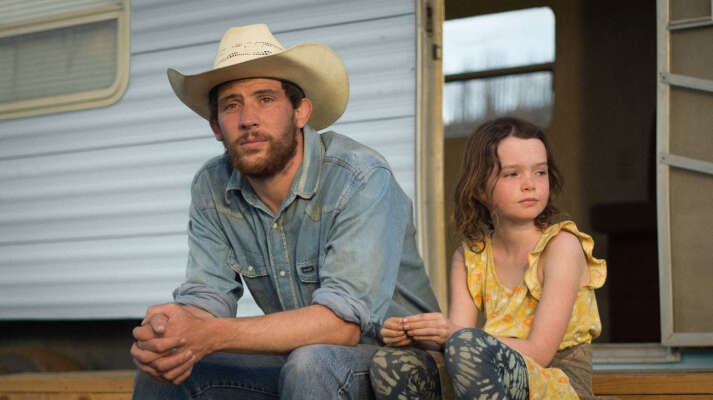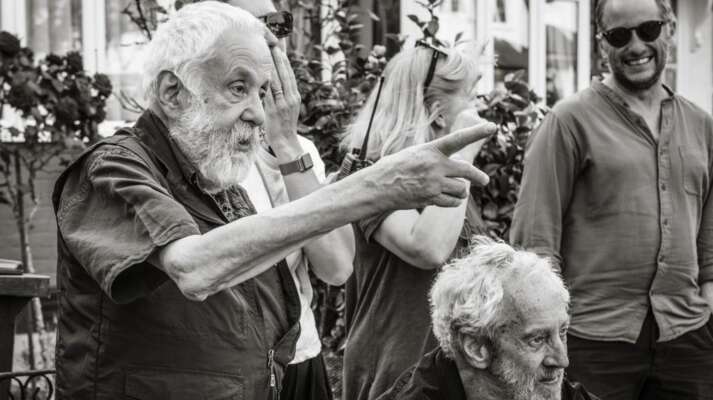Film and the City
From Nashville to Paterson
Film and the City
Written by Peter Bowen
PATERSON | Paterson, NJ
In Jim Jarmusch’s PATERSON, a bus driver and poet named Paterson (Adam Driver) lives in the New Jersey town of Paterson, using his experience ferrying people across town as the rough material for his poetry. In line with William Carlos Williams’ five-volume epic poem, Paterson, which takes the city as both subject and metaphor, Jarmusch’s film allows us to see the city as wondrously and imaginatively as Paterson does. And like with Paterson’s poetry, Jarmusch uses the city’s history and architecture to play a poignant part in his drama. In portraying real-life locations, Jarmusch and his production designer, Mark Friedberg, show off the city’s fascinating and complex history. “Its nobility is seemingly very former, certainly architecturally,” notes Friedberg. “At the same time, it’s a beautiful, colorful collage of life, and I think we were interested in that dichotomy—we were looking to find that sense of both despair and hope.” At the bar, which Paterson visits nightly, the owner, Doc (Barry Shabaka Henley), keeps a shrine to the town’s famous former residents, from comic actor Lou Costello to boxer Rubin “Hurricane” Carter. “It’s a Paterson we created,” says Jarmusch. “It does reference many people who were from or lived in Paterson…but it’s not a social document.” Such attention to detail and history makes PATERSON,according toVanity Fair’s Richard Lawson, “one of the more loving film depictions of a small American city in recent memory.” In the spirit of PATERSON, we look at other great films whose cities became an integral part of their story.
Nashville | Nashville, TN

Robert Altman’s epic 1975 film, Nashville, began not with a city, but a song. At a party in Mississippi during the production of Altman’s Thieves Like Us, actor Keith Carradine pulled out his guitar to sing a few tunes he’d been working on, including the ballad “I’m Easy.” “When I heard them I knew I wanted to base a whole movie around them, a movie that would simply give me an excuse to put them in,” Altman remembers. That same year, he’d been asked to consider a musical about country music called The Great Southern Amusement Company. While he disliked the script, the idea intrigued him. He approached screenwriter Joan Tewkesbury about travelling to Nashville to see what she could come with around the subject of country music. A few weeks later, she returned with an epic tale in which the lives of 16 characters, both famous and everyday, intersect. Thrilled by the structure, Altman took the script, added eight more characters, and gave the entire piece a decidedly political slant. In the wake of Richard Nixon’s re-election, Altman saw Nashville (both the city and the film project) as a metaphor for America and its political contradictions. In Patrick McGilligan’s biography, Robert Altman: Jumping Off the Cliff, the director explains that Nashville is “a place where people get off the bus, like Hollywood was many years ago. The money is generated and there's a crudeness to the culture. It just seems like the proper place for me to be able to equate the analogy of our elected officials and politicians––which in many ways, I think, is a popularity contest ––with the success of country and western music….it's just a way of melding a whole view, my view, of the political climate in America today.” For his cast, Altman went out of his way to make unusual choices, often picking comic performers (like Henry Gibson and Lily Tomlin) for serious roles, and serious ones (like Geraldine Chaplin) for comic parts. Over the four days of its story, Nashville travels through all parts of the city, weaving together the lives of Country stars and aspiring singers, presidential candidates and short-order cooks, housewives and good-old boys, before reaching its surprising and violent climax. When it premiered, most film critics found its vision of America revelatory. The New Yorker’s Pauline Kael called it “the funniest epic vision of America ever to reach the screen.” Roger Ebert took the movie more seriously, writing in the Chicago Sun-Times, “This is a film about America. It deals with our myths, our hungers, our ambitions, and our sense of self. It knows how we talk and how we behave, and it doesn't flatter us but it does love us." The city of Nashville, however, did not love the film back. The audience of music professionals gathered at the film’s Nashville premiere were not amused by Altman’s portrayal of their city, their industry, or their music. Singer Brenda Lee told reporters on her way out that she had “one word” to describe the movie, but her husband wouldn’t let her say it. Many were angry that Altman had refused to use local talent or music for the soundtrack, instead letting his actors, like Keith Carradine, write their own songs. The film garnered five Academy Award nominations, including Best Director and Best Picture. But it only won Best Original Song for “I’m Easy,” the tune that set the whole thing in motion. In the years since its debut, many in Nashville have given the film a second viewing. In The Dissolve, Noel Murray writes, “Whether it’s meant to capture Nashville or not, though, Nashville does take place in the city where I grew up, and enough of that city’s genuine character comes through that even at 16, I recognized the movie as being true—or at least true enough.”
Drugstore Cowboy | Portland, OR

In 1988, the up-and-coming film production company, Avenue Pictures, ponied up several million dollars to make a new film called Drugstore Cowboy. The film was based on an unpublished novel by an inmate at Washington State Penitentiary about a group of drug addicts robbing pharmacies. It was to be directed by a young director, Gus Van Sant, whose previous picture, Mala Noche, had been a $25,000 self-financed black-and-white film about a gay convenience store clerk in Portland who falls for a Mexican teenager. Despite Drugstore Cowboy’s gritty origins, the screenplay, adapted by Van Sant, attracted a talented young cast, including Kelly Lynch, James Le Gros, Heather Graham, and Matt Dillon as the gang’s leader, Bob Hughes. Van Sant, who knew Portland well, used locations all about town, including the Pearl District, an old rail yard in the industrial section, to give the film an insider’s sensibility. Film critics found Van Sant’s vision both original and true. Roger Ebert was not alone in claiming, “This is one of the best movies of the year.” For The Los Angeles Times’ Shelia Benson, “the picture keeps its own authenticity all the way down the line,” including the “production designer David Brisbin's eye for tacky Portland motel rooms, rooming houses, and suburban cracker-boxes.” The film went on to win a host of awards, including Best Film, Best Director, and Best Screenplay from the National Society of Film Critics. While Portland has changed drastically in the years since Van Sant used it as his own private film set, Drugstore Cowboy still captures something essential about the town. Willamette Week’s Becky Ohlsen whimsically notes, “Drugstore Cowboy, more than any other film ever shot in the city, shows what made Portland unique. Not just physically—Benson Bubblers, Tom Peterson commercials, Union Station, Multnomah Falls—but in spirit. Van Sant's crew of addicts in Drugstore Cowboy, led by Bob Hughes (Matt Dillon), operates according to a strict code. They're not slackers or half-employed hipsters. …There's an element of rigor and craftsmanship to Bob's lifestyle—he just happens to apply himself in a nontraditional line of work. Classic Portland.”
Slacker | Austin, TX

In 1991, film curator and part-time filmmaker Richard Linklater embarked on his second feature. His first, a super-8 travelogue,It's Impossible to Learn to Plow by Reading Books, got almost no distribution, but its production practice and filmmaking style prepared Linklater to make Slacker, the film that would launch his career. Using a documentary style and cast of new actors who come off more like unsuspecting citizens than performers, Linklater’s film moves through the Texas college town to discover a community of people bound together by their differences from each other and utter indifference to societal precepts of normalcy. As Linklater explained in his grant application, “Slacker is primarily about people on the fringes of any meaningful participation in society.” As some film scholars point out, the film is as much about a moment in time as a cultural space. Austin Scholar Brendan Gaughen notes, “Austin was a much less expensive city in the late 1980s and early 1990s, which certainly helped make it possible for part-time workers (and full-time dropouts) to pursue esoteric aims like memorize the minutiae of the JFK assassination, dispose of symbolic typewriters, and document every possible moment on videotape.” As part of that world, Linklater shows a profound love for his odd neighbors and the world they create together. As Entertainment Weekly’s Owen Gleiberman proclaims, “the movie never loses its affectionate, shaggy-dog sense of America as a place in which people, by now, have almost too much freedom on their hands.” For many Americans who only knew the town as Texas’ capital, the film transformed Austin to a unique cultural destination. “Few of the many films shot in Austin over the past 10 or 15 years even attempt to make something of the way its citizens live,” notes The Austin Chronicle’s Chris Walters. “Slacker is the only one I know of that claims this city's version of life on the margins of the working world as its whole subject, and it is one of the first American movies ever to find a form so apropos to the themes of disconnectedness and cultural drift.” After creating a buzz in various film festivals, Linklater’s $23,000 film experiment was picked up by Orion Classics, where it became a box-office hit. The film not only helped, as so many local bumper stickers request, “Keep Austin Weird,” but also turned the town into a new powerhouse for independent filmmaking.
Singles | Seattle, WA

Writer/director Cameron Crowe originally imagined his romantic drama Singles taking place in Phoenix, but a late-night phone call changed both the film’s location and tone. Crowe and his wife, Nancy Wilson of the band Heart, were in Seattle when they learned of the death of Andy Wood, the front man of the local band, Mother Love’s Bone. The two rushed over to a nearby home where a community of people had gathered in a friend’s living room to bond and mourn their compatriot. “I was in the process of rewriting an old script of mine at the time. It was called Singles,” Crowe writes in Rolling Stone. “That night it took a different course. I wanted to write something that captured the feeling in that room. Not Andy's story but the story of how people instinctively need to be together.” Crowe moved his drama of a group of singles looking for love to a Seattle apartment complex, adding in elements from the emerging grunge music scene to give it texture. Along with Campbell Scott as a traffic engineer and Bridget Fonda as a waitress, Crowe cast Matt Dillion as an aspiring musician, whose band Citizen Dick sported real life musicians Eddie Vedder, Stone Gossard, and Jeff Ament (who at that time formed a band called Mookie Blaylock). To give local texture to his character, Dillon borrowed clothes from Ament’s wardrobe. While in hindsight, the casting of musicians, as well songs from Soundgarten and Mudhoney, make Singles feel like a docudrama about grunge music, Crowe explains in Rolling Stone that “it's not a movie about the birth of the now-hot Seattle scene or even the story of how Mother Love Bone gained a new singer (Eddie Vedder) and became Pearl Jam. It's the story of disconnected single people making their way, forming their own unspoken family.” Despite Crowe’s intentions, studio executives wanted to capitalize on the film being at the right place at the right time, even going so far as suggesting it change its name to Come As You Are(a popular song by Nirvana at the time), even though Nirvana had nothing to do with either the story or the film’s production. The movie nevertheless captured the spirit of Seattle in unexpected ways. Seattle Times’ John Hartl notes, “So much of Seattle is in this movie, and so much of it looks so inviting and glamorous, that critics in other parts of the country are already sounding envious.” As if to make his point, Entertainment Weekly’s Tim Appelo writes in his review “Crowe captures the eccentric appeal of a town where espresso carts sprout on every corner and kids in ratty flannel shirts can cut records that make them millionaires."

Medicine for Melancholy | San Francisco, CA
Before filmmaker Barry Jenkins lyrically captured growing up in Miami’s Liberty City in Moonlight, he’d turned his camera on the Bay Area to explore what it felt like to be a African-American transplant in San Francisco. His 2008 romantic drama, Medicine for Melancholy, follows a couple, Wyatt Cenac and Tracey Heggins, who wander through the streets of San Francisco after an unanticipated one-night stand. While the story is not autobiographical, the film’s perception of the city is. “As a person of color from the South, San Francisco was the first city that really made me feel like an other,” Jenkins tells The New York Times. While the locations speak to the San Francisco’s iconic status as a destination for artists and iconoclasts, the couple talk about, among other things, how the new economy has pushed out many African-American families from being able to live in the city. By the mid-2000s, San Francisco had lost proportionally nearly a third of its 1970s’ African-American population. To blend the political and the cinematic, Jenkins designed his San Francisco to be given a poetic and romantic look by having the images de-saturated to an almost monochromatic palette, a feature he ironically explains reflects “the theme of a city with the color taken out.” For locals, the film offers a touching take on their hometown. The San Francisco Chronicle’s Mick LaSalle writes, “Beautiful use is made of the film's San Francisco location. If only life were as interesting as Jenkins makes it look––but then, maybe it is, and we don't see it.” But as much as Jenkins wanted his audience to love the city, he also wanted them to think about it. “I think the film presents a portrait of the city and these characters and leaves you with the very same questions,” Jenkins tells SF360. “Are we a society where racial divisions are dissolving or a society where one culture dominates another? Are we a city where the upper-middle class and the poor coexist on the porches of cafes and in modest taquerias or one where the influx of wealth displaces the economically disadvantaged into smaller and smaller pockets of the city removed from its cultural, political and economic dialogue?”


